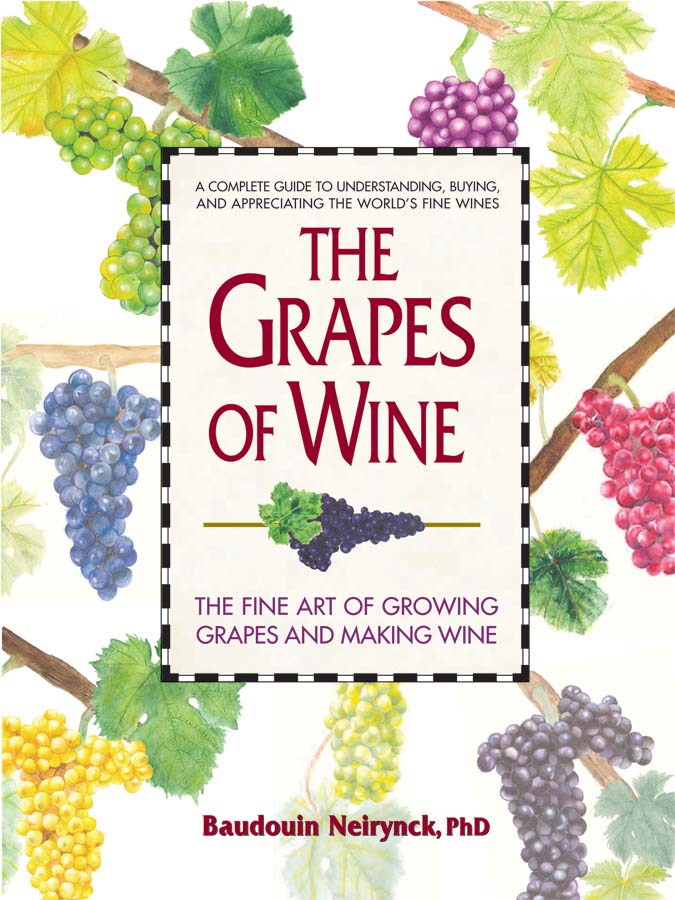The ancient Greek philosophers called them elixirs of the gods. The Roman emperors used them to celebrate their victories. And today, fine wines are still being treasured and enjoyed. How and why these wines reach their zenith in color, flavor, and value is the focus of this beautifully illustrated book by wine connoisseur Baudouin Neirynck.
The book first looks at the activities of growing grapes and making wine. This is followed by a discussion of the twenty most popular white and black grapes responsible for great wines, from Chardonnay to Sangiovese. Included are chapters on investing in wines, storing and serving wines, matching wines with foods, reading wine labels, and even the health benefits of wine. Whether you are a wine expert or simply someone who enjoys an occasional glass of wine with your meals, The Grapes of Wine is as mesmerizing as a glass of the finest Cabernet Sauvignon.
Baudouin Neirynck, PhD, has degrees in both Hotel and Restaurant Management and Food Science. He has held food and beverage management positions in some of the world’s finest hotels, including The Mandarin Oriental (Hong Kong), the Le Mirador (Mont-Pélerin, Switzerland), and The Red Sea Palace Hotel (Saudi Arabia). Currently, he teaches Wine, Food, and Beverage and Hotel Management courses at the Institute for Tourism Studies in Macau.
Table of Contents
Dedication
Acknowledgements
Foreword
Introduction
Part 1: The Art of Making Wine
1. Wine and Grapes through History
2. Grape Growing
3. Wine Production
Part 2: Grapes of the World
4. Grape Classification
5. White Wine Grapes
6. Red Wine Grapes
Part 3: The Pleasures of Wine
7. Wine Service
8. Wine Tastings
9. Wine Storage and Investment
10. Matching Wine and Food
11. Wine Labels from Around the World
12. Wine and Health
Conclusion
Glossary
Bibliography
Index
In some countries, wine has been considered a daily staple for centuries. Other countries, where wine consumption may have been nonexistent just a few decades ago, have seen the emergence of a wine culture that has grown exponentially. Local wine shops and tasting clubs proliferate, while wines from all around the world are more readily available, thanks to improved distribution networks.
I traveled from Saudi Arabia to Hong Kong in 1987. Only during the last twenty years has wine begun to replace Cognac and other hard liquors as the alcohol of choice at Chinese banquets and wedding parties. The number of specialized wine shops in Hong Kong multiplied by twenty-five between 1987 and 2006. Knowledge and interest is such that a few die-hard amateurs have even been studying for the Master of Wine (MW) examination--the hardest test in the wine trade.
In Beijing in the year 2000, the Chinese government decided that dry, grape-based wine should replace hard liquor and rice wine at all official state banquets. This decision was based on the more economic use of natural resources, including water, for wine production, as compared with the production and distillation of rice (the base grain for the famous rice wine maotai). Regardless, the result was the further advancement of the global wine market.
For Europeans, on the other hand, wine is an integral part of culture. My grandfather had nine children: seven daughters and two sons. In Europe in the 1920s and 1930s, it was customary for the bride’s family to organize (and bear the cost of) her wedding. Three to four years after each daughter was born, my grandfather would buy a barrel of a specific wine--usually from Bordeaux--and have it shipped to his home in Belgium, where it was bottled by a local merchant. The bottles belonging to each girl were drank on the day of her wedding. (One of his daughters did not marry--but the wine was consumed anyway!) Every twenty years, the merchant would examine the bottles and taste the remaining stock, top up bottles with wine from the same vintage (to replace any liquid that may have evaporated), and change the corks. Today, this practice is referred to as a Wine Clinic.
At my grandfather’s house, the process of choosing a bottle to accompany lunch was a ritual of almost religious proportions, and visits to the cellar to show his latest acquisitions to business associates were customary. Admittedly, this did not happen in every household. There were many people who could only afford to drink beer.
It was the dedication of my family to wine that inspired me to venture into the food and beverage industry, and restaurant management in particular, where I remained for two decades (1977 to 1997). Today, I am delighted to share my wine passion with you through this book.
A VARIETAL APPROACH TO THE STUDY OF WINE
Typical wine books tend to focus on the acquisition of wine knowledge by presenting information country by country, and region by region. As recently as fifty years ago, a large majority of wines originated from the Old World (essentially from Europe). Since one of the most important influences on the character of these wines was the precise vineyard in which its grapes were grown, this geography-focused approach worked well. After all, these wines are labeled by the vineyard in which the grapes originated. Consumers of European wine rely on the advice of a wine merchant and their own knowledge of wine geography to make a distinction between varying quality, origin, type, and style of wine.
In today’s global wine market, however, there are as many popular wines originating from outside Europe as from within. We are seeing two very different approaches between Old World and New World winemakers. Most wines from the New World are varietals--wines produced from one or more grapes that are labeled by the name of the grapes used. When looking to buy wine, consumers have shifted their attention towards the comparison of different wines made from the same grape variety, and these wines may even come from more than one country.
Thus consumers now require global knowledge of the multitude of labels and brands, not only from different regions, but also different countries and different continents. As a result, there seems to be an argument for enhancing the information given on a wine label, and a move towards standardizing at least part of worldwide wine-production. The result of this argument may eventually be the production of varietal wines in the Old World. The results of a 2001 study by Jacques Berthomeau, a French wine consultant, suggested that the gradual adoption of varietal naming and stronger branding would improve the position of French wines in an increasingly competitive export market. In other words, he recommended that this ultra-traditionalist country implement a more consumer-friendly system.
There is, after all, consensus in the wine trade that understanding the most important grapes and the resulting wines from around the world is more significant than having specialized knowledge about selected wines from just one or two countries. Apart from some restaurants located right in the middle of a wine-producing region, which can get away with listing exclusively local wines, the majority of eateries in tourism-oriented areas need to offer a broad choice of wines from across the world. In this respect, sommeliers--restaurant wine stewards--need to have generalist, rather than specialist, knowledge.
As grape varieties continue to emerge as more important than place of origin, a different approach to wine education is required. There are calls to shift the paradigm of wine education that was previously centered on geography towards the study of grape varieties across wine-producing regions. With this in mind, the objective of this book is to explain the historical background of wine, viticulture, and vinification, as well as offer a comprehensive exploration of wine through the various grapes cultivated in major wine-producing countries, both Old World and New World. It concludes with information on wine service and storage, as well as ideas on how to approach food and wine matching. However, this book is not intended to be an ampelographic description of all the grapes used in the production of wine but, rather, an exploration of the most popular wine grapes and their origins, development through the ages, and current geographic spread. It also explores the importance of these grapes and olfactory qualities associated with the various regions of production.
I have limited the number of grapes discussed in this book to a little more than twenty. I reached this total by determining both the most significant grapes and those in highest demand in today’s market.
Among the white wine grapes, we start with Chardonnay, which has achieved worldwide recognition and has a cult following among wine drinkers and tasters. Sauvignon Blanc follows, mainly due to the fact it has succeeded in propelling New Zealand to the forefront of wine-producing countries. Next we look at Riesling, the grape that has, with its balance of firm acidity, floral aromas, and varying degrees of sweetness, established the wine reputations of Germany and the Alsace region of France.
Gewürztraminer, although produced only in minute quantities when compared with the other major grapes, is the most aromatic of white grapes, and is a must for beginners in the art of wine tasting. The Semillon grape, responsible for some of the most famous naturally sweet wines such as Château d’Yquem, is also on the list of major grapes. We will also look at Ugni Blanc, which is known as Trebbiano in Italy. This is the most widely planted grape in the world, and is appreciated not so much for its olfactory characteristics but for its ability to produce, when distilled, the best Cognacs in the world.
Then, we will turn to a host of other white grapes. These are all significant either in terms of plantings or due to their specific olfactory characteristics and future development potential.
Of the black grapes, also called red wine grapes, we begin with those utilized in the Bordeaux region of France. Cabernet Sauvignon is the first and foremost, not so much for its aromas and smells as for what it brings to a wine in terms of structure, body, and sophistication. Merlot, the grape of which Château Petrus in Pomerol is made, is a thick-skinned berry capable of producing highly aromatic wines. The two other main grapes of the region are Malbec and Petit Verdot.
The black grape Syrah is called Shiraz in Australia and, sometimes, California. Shiraz is a luscious wine that not only retains all the typical characteristics of the Syrah grape, but adds a depth previously unseen. Pinot Noir, responsible for some of the most prestigious wines in the world, is a more delicate grape that needs certain soils and climatic conditions to give its best. Grenache, also called Canonnau, is one of the oldest grapes officially recognized in ampelographic records. It was originally popular from its usage in French and Spanish wines, but has since been grown with success in California as well.
Sangiovese is the undisputed king of Italian grapes, and an important part of the production of Chianti. Malbec and Tannat are upcoming grapes which have established substantial reputations, not so much in their native country of origin--France--but in their countries of adoption, Argentina and Uruguay respectively. Carignan is one of the oldest-documented grapes, and has spread far and wide on every continent to become one of the most planted grapes in the world. Tempranillo, the Spanish grape, has long been highly regarded for its part in generating famous wines from La Rioja to Ribera del Duero. Lastly, the Venetian grape Primitivo has been adopted by California under the name Zinfandel with such success that Italian winemakers have also begun to adopt this new moniker.
Sideways, a 2004 movie by Alexander Payne, illustrated the current debate in the wine market by epitomizing the myriad of choices facing today’s consumers when selecting a wine. Should they go for an oak-influenced, high-alcohol-content Merlot or a super-elegant Pinot Noir with its finesse and higher acidity? In fact, every grape has its own cult following.
WHICH WINES FOR WHICH CONSUMER
Choice is a matter of preference and price, particularly in the case of wine. The proponents of high-end French, Californian, Spanish, Australian, and Italian wines can make a strong case for their choices. Such wines have been brought to life in a very traditional way, from careful selection of soil and grape type to attentive handling during harvest, vinification, and maturation. They represent the best of the best from each wine region. They are worth their price as well as the years of waiting required before they achieve maturity. These top-notch wines regularly contribute significantly to the bottom line of auction houses because great wines are the subject of much speculation. However, they are reserved for a particular breed of consumer who has the time, financial resources, and facilities to buy and cellar these treasures.
On the other hand, the majority of wine drinkers have neither an appropriate cellar nor the purchasing power to acquire truly exceptional bottles. For them, there exists a range of reasonable and sometimes high-quality wines that do not need to mature. There is usually a price range of between $10 and $15 (€7.47 and €11.20) per bottle.
A WINE FOR EVERY OCCASION AND BUDGET
You may find that you derive as much pleasure from sharing a relatively good-quality fruity wine with little or no oak flavor and very little tannin, as from opening a 1945, 1959, 1982, or 2003 vintage of a great Bordeaux, or a bottle of Grange or Opus One. After all, not everyone thinks like Marco-Pierre White, the prominent British chef, who said that he would find solace and happiness if he could drink his favorite wine, 1947 Château Cheval Blanc, every day. We can think of numerous wine-drinking occasions--official banquets, weddings, birthdays, funerals, and wine tastings, to name a few--but not everyone wishes to indulge in the most sophisticated red wine every day. Some wines are delightful precisely because they are simple, approachable, and easy to drink. There are as many different wines as there are events at which to drink them. You may find it helpful to peruse a wine magazine, or the weekend editions of daily newspapers, as they very often contain a wine section. Such publications usually highlight wines for every budget. Enjoy your reading--as well as your drinking.





